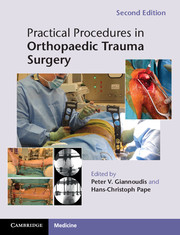Book contents
- Frontmatter
- Dedication
- Contents
- List of Contributors
- Preface
- Acknowledgements
- Part 1 Shoulder girdle
- Part 2 Upper extremity
- Part 3 Pelvis and acetabulum
- Part 4 Lower extremity
- 10 Section I: Extracapsular fractures of the hip
- 11 Section I: Fractures of the femoral shaft
- 12 Fractures of the patella
- 13 Section I: Fractures of the proximal tibia
- Section II: Fractures of the tibial shaft
- Section III: Fractures of the distal tibia
- 14 Fractures of the ankle
- 15 Fractures of the foot
- Part 5 Spine
- Part 6 Tendon injuries
- Part 7 Compartments
- Index
Section II: Fractures of the tibial shaft
Published online by Cambridge University Press: 05 February 2014
- Frontmatter
- Dedication
- Contents
- List of Contributors
- Preface
- Acknowledgements
- Part 1 Shoulder girdle
- Part 2 Upper extremity
- Part 3 Pelvis and acetabulum
- Part 4 Lower extremity
- 10 Section I: Extracapsular fractures of the hip
- 11 Section I: Fractures of the femoral shaft
- 12 Fractures of the patella
- 13 Section I: Fractures of the proximal tibia
- Section II: Fractures of the tibial shaft
- Section III: Fractures of the distal tibia
- 14 Fractures of the ankle
- 15 Fractures of the foot
- Part 5 Spine
- Part 6 Tendon injuries
- Part 7 Compartments
- Index
Summary
Indications
Management of acute closed and open (types I, II, IIIa and IIIb according to Gustilo classification) tibial shaft fractures.
Failed non-operative treatment of tibial shaft fractures.
Late management of open tibial fractures or when the definitive care is implemented after the damage control orthopaedics concept in a polytraumatized patient, i.e. conversion of an external fixator to an intramedullary nail.
Clinical assessment
History of the mechanism of injury. May be high-energy injury associated with considerable soft tissue damage.
History of increasing disproportionate pain suggests compartment syndrome. Early detection and appropriate documentation of this condition is especially important, since intramedullary nailing of closed tibial fractures has been associated with increased incidence of compartment syndrome.
Assess and document the neurovascular status of the leg.
Complete physical examination.
Careful examination for open wound (20–25% of patients). Obtain a photograph of the injured leg at presentation and keep it in the patient's records for future reference (medical and medicolegal issues). Assess the need for early involvement of a plastic surgeon in the management (act according to local protocols, and clearly document the management plan).
- Type
- Chapter
- Information
- Practical Procedures in Orthopaedic Trauma Surgery , pp. 346 - 360Publisher: Cambridge University PressPrint publication year: 2014



